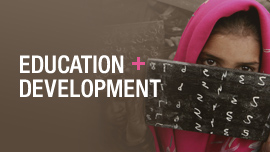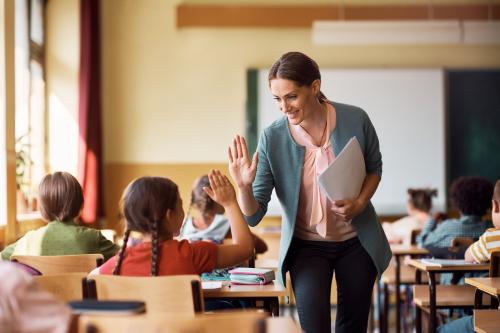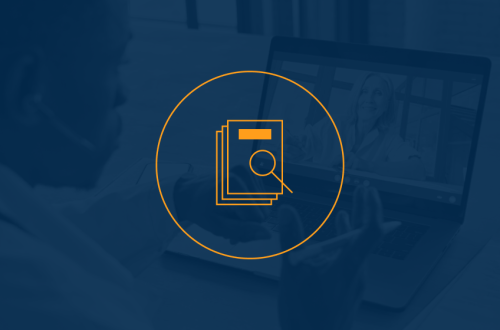In late January 2025, the U.S. Department of Education criticized the latest National Assessment of Educational Progress (NAEP) results and raised alarm about what they mean for our nation’s students. We acknowledge the concern about the latest scores. The NAEP is widely considered the “gold standard” assessment of student achievement at the national level, and has for decades offered valuable insights into the performance of our education system. Yet, it is still vital to put the most recent NAEP results in context. Between 2017 and 2024, the percentage of fourth graders who achieved at least proficient on the NAEP ranged from 31% to 37% in reading and from 36% to 41% in math. While the administration raised alarms about the 2024 results, the percentage of students meeting proficiency has been low for years, even before the challenges of the COVID-19 pandemic.
The NAEP defines proficiency as a demonstration of “solid academic performance and competency over challenging subject matter.” Acknowledging the fact that NAEP proficiency is not equivalent to grade-level proficiency, how do we help all students reach this higher goal? The Department of Education’s statement expressed their commitment to “prioritize meaningful learning, and provide universal access to high-quality instruction.” But what is high-quality instruction? In an era when the same statement calls for “fully empower[ing] states” to make educational decisions, how can we, as researchers, policymakers and supporters of children, families, and schools ensure that high-quality instruction is not just a buzzword, but implemented in a way that is consistent with the evidence from the science of learning and accessible to all students?
Promoting student achievement on the NAEP, along with the breadth of skills that students need to thrive, requires more than testing what children know. It requires an understanding of how children learn. If we teach in the way that human brains learn, we can optimize outcomes. And here, the science of learning offers clear findings and a path forward.
Today, our teaching─even in kindergarten and other early grades─emphasizes direct instruction, which prioritizes delivery of content to students by the teacher. However, research suggests that a recent period of intensified focus on direct instruction after the passage of the federal No Child Left Behind Act in the U.S. did not coincide with broad gains in student achievement. The latest NAEP scores are a testament to this point, as direct instruction remains prevalent. This trend is particularly clear in the early childhood and elementary grades. For example, researchers conducted independent observations of 100 classrooms from 25 schools in Tennessee in Fall 2019. The results revealed that teacher-directed instruction delivered to the whole class was the most common pedagogical approach across all grade levels included in the study, from pre-K through second grade. Indeed, even pre-K students spent 22% of the school day receiving this type of instruction. Another recent study of 179 pre-K through third-grade classrooms from the Midwestern U.S. likewise found that direct instruction was the most common pedagogical method, overall.
Stakeholders also aimed to boost student achievement, particularly in response to the COVID-19 pandemic, with high-impact tutoring. In many ways, these programs are the opposite of direct, whole-class instruction. Students are required to meet with their tutor for a substantial amount of time each week (broadly defined as at least three sessions per week for a minimum of 10 weeks, as developmentally appropriate), rely on a strong student-tutor relationship, occur one on one or in small groups, prioritize student growth, maintain alignment with the school curriculum with high-quality instructional materials, and ensure appropriate oversight of tutors. A growing body of evidence demonstrates how students benefit from tutoring, and high-impact tutoring in particular. However, some of the same research that documents the effectiveness of tutoring raises questions about its benefits beyond particular subject areas and its scalability. That is, students might be more prepared for the test in math, but they are not learning the kinds of critical thinking skills that generalize to reading. For example, a 2021 report on the state of high-impact tutoring noted “little rigorous evidence evaluating tutoring programs that are not subject-focused … or [focused on] other subject areas besides math and reading,” indicating a need for additional research. Further research on how high-impact tutoring affects outcomes like student motivation and behavior is also advised. More recently, a 2024 meta-analysis of 89 tutoring studies did not identify any studies that did not target literacy or math. In practice, educators report scalability challenges regarding tutor quality, space and time constraints, and costs.
If passive learning is prevalent but seemingly ineffective at promoting student achievement, it is time to explore pedagogical options that are theoretically sound and practical for teachers to administer. Note, the curricula can stay the same, but the way in which the subjects are taught needs a makeover. Teaching in the way that students learn matters.
Students learn through high-quality experiences and by interacting with their environment and with others. Empirical studies demonstrate the benefits of these principles in the classroom. For example, decades of research on Montessori shows how its teacher-curated approach to experiential, playful learning in early childhood supports a variety of student outcomes, including in measures of math and reading. Additional studies documenting the impacts of project-based learning in later grades indicate benefits, such as improved performance on Advanced Placement exams and greater knowledge gains based on state exam scores. Our ongoing research adds to this movement to put evidence from the science of learning into practice. Our Active Playful Learning framework advances achievement with a broader perspective through a figurative “three-part equation” that taps parental input, recognizes how children learn, and takes a broader look at what students need to succeed in school and beyond. Initial research we’ve conducted on the early implementation of this approach, including in a forthcoming Brookings Institution working paper, describes pedagogical practices that emphasize active, hands-on and minds-on learning, engaging and socially interactive instruction, and joyful education, among other elements. Our emerging evidence suggests that this kind of instruction is feasible and beneficial in classrooms; it positively impacts students’ learning experiences and teachers enjoy teaching in this way.
The latest NAEP scores highlight a dire need to improve student achievement in math and reading. Yet, the research suggests that simply dedicating more time to direct instruction in these subjects or intensive tutoring is not the answer, particularly if the goal of education is to promote a deeper understanding of content and mastery of a breadth of skills. Fortunately, evidence from the science of learning offers guidance on what “high-quality instruction” looks like to achieve this aim. Policymakers must follow the latest evidence to ensure that children have the skills that they will need to work in the jobs of tomorrow.
The Brookings Institution is committed to quality, independence, and impact.
We are supported by a diverse array of funders. In line with our values and policies, each Brookings publication represents the sole views of its author(s).








Commentary
What does ‘high-quality instruction’ look like?
Responding to the latest Nation’s Report Card results with evidence
May 14, 2025